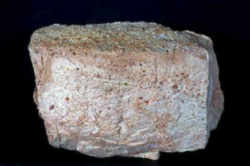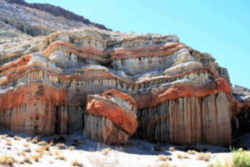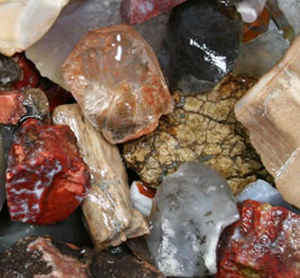Nevada State Rock
Sandstone

Adopted in 1987.
The state rock is sandstone. It was adopted as Nevada State Rock in 1987. Sandstone, in its more traditionally recognized form or as quartzite, is found throughout the state. In areas such as the Valley of Fire State Park and Red Rock Canyon Recreational Lands, both near Las Vegas, it provides some of Nevada's most spectacular scenery. The State Capitol, and the former United States Mint, are built of sandstone. Students at Gene Ward Elementary School in Las Vegas came up with the idea of making sandstone our state rock.
Nevada State Rock: Sandstone
Sandstone is Nevada's official state rock
 By HENRY BREAN
By HENRY BREAN
LAS VEGAS REVIEW-JOURNAL
The official state rock of Nevada gives color
to Valley of Fire and Red Rock Canyon and keeps the rain and snow off some pretty important people in Carson City.
Sandstone is everywhere in the Silver State, and so was the sand that produced it.
For millions of years, much of what is now Nevada was collecting sediment at the bottom of an early Mesozoic ocean. Millions of years later, the same
area was covered by a massive sand-dune desert trapped on the dry side of an Andes-style wall of mountains that blocked moisture from the sea.
Those mountains were the precursor to the Sierras, only with active volcanoes on top, said Wanda Taylor, a geology professor at UNLV.
"The Sierras are the guts of old volcanoes,"she said. "We have the dinosaurs running around the edges of the dunes, looking for water,
and we have volcanoes spewing ash on them."
Starting in 2010, hikers and then geologists began finding fossilized dinosaur footprints in the sandstone cliffs of Red Rock Canyon National Conservation
Area.
Specifically, the prints turned up - and are still turning up - in a roughly 190 million-year-old layer of Aztec sandstone, the same type of rock in
which dinosaur tracks and bones have been discovered in Utah and Arizona.
Far more recently, Northern Nevada sandstone was used to build a number of prominent buildings in Carson City, including the state Capitol itself.
Historian and former state archivist Guy Rocha said the stone was quarried from the grounds of the old Nevada State Prison by some of the involuntary
guests there. (In deference to the sesquicentennial, we'll refrain from making any jokes about a state Capitol built by criminals.)
Said Rocha: "When you travel through Carson City, you see a lot of sandstone quarried at the old state prison. It was one of the principal building
materials at that time."
But it took a while for sandstone to receive its due.
A group of fifth graders at Gene Ward Elementary School in Las Vegas launched the campaign to make sandstone Nevada's state rock in the 1980s. Their
efforts succeeded in 1987.
Today, the achievement is memorialized at the school on Hacienda Avenue near Spencer Street with a small metal plaque and a large pink boulder that
used to be plain old sand.
- Henry Brean/Las Vegas Review-Journal
The Rock - Sandstone
 Sandstone is a very common sedimentary rock
and perhaps the best known sedimentary rock. It is formed in many environments. Just about anywhere there is water, whether frozen or not, in a river
or ocean, there is a chance to form sandstone. Even where there is no water as in a desert, there is sandstone formation under foot.
Sandstone is a very common sedimentary rock
and perhaps the best known sedimentary rock. It is formed in many environments. Just about anywhere there is water, whether frozen or not, in a river
or ocean, there is a chance to form sandstone. Even where there is no water as in a desert, there is sandstone formation under foot.
Most sandstone is composed of quartz and/or feldspar because these are the most common minerals in the Earth's crust. Like sand, sandstone may be any colour, but the most common colours are tan, brown, yellow, red, grey, pink, white and black. Since sandstone beds often form highly visible cliffs and other topographic features, certain colours of sandstone have been strongly identified with certain regions.
- Sedimentary Rock Type: Clastic
- Related to: Shale, conglomerate, siltstone, breccias
- Distinctive features: Sandstone is a sedimentary rock. Sand in which the grains are cemented together by secondary silica calcite. Maybe loosely cemented and soft or well cemented and hard.
- Composition: Sand grains (quartz), cemented by secondary silica or calcite.
- Color: Medium grey in color to brownish; sometimes reddish, due to presence of iron oxides, or greenish, due to presence of glauconite.
- Texture and granularity: Sandy, with grains up to 2 mm ( 1/16 in) in diameter.
- Origins: River, ocean, glacier and desert deposits
- Common Minerals: Quartz, feldspars, micas, calcite and clays
- Uses: Building material, decorative stones, tiles, tombstones, monuments, roads, ore of silica for glass, abrasives, aquifers, petroleum reservoirs
- Field associations: Compound and / or cemented ancient beach, river, delta, lake and desert deposits. Occurs as thick, stratified beds in sedimentary sequences, often showing current or dune bedding.
- Varieties: Quartz sandstone, which has cemented rounded or angular quartz grains; greywacke; arkose; and calcareous sandstone, which has a high proportion of calcite, usually as cement.
Nevada Law
The law designating the rock known as sandstone as the official Nevada state rock is found in the Nevada Revised Statutes, Title 19, Chapter 235, Section 235.120.
TITLE 19- MISCELLANEOUS MATTERS RELATED TO GOVERNMENT AND PUBLIC AFFAIRS
CHAPTER 235 - STATE EMBLEMS; GIFTS AND ENDOWMENTS
MISCELLANEOUS STATE EMBLEMS
STATE SEAL AND MOTTO
NRS 235.120 State rock. The rock known as sandstone is hereby designated as the official state rock of the State of Nevada.
(Added to NRS by 1987, 539)
Minerals, & Gems

Gemstone, Minerals, Rocks







